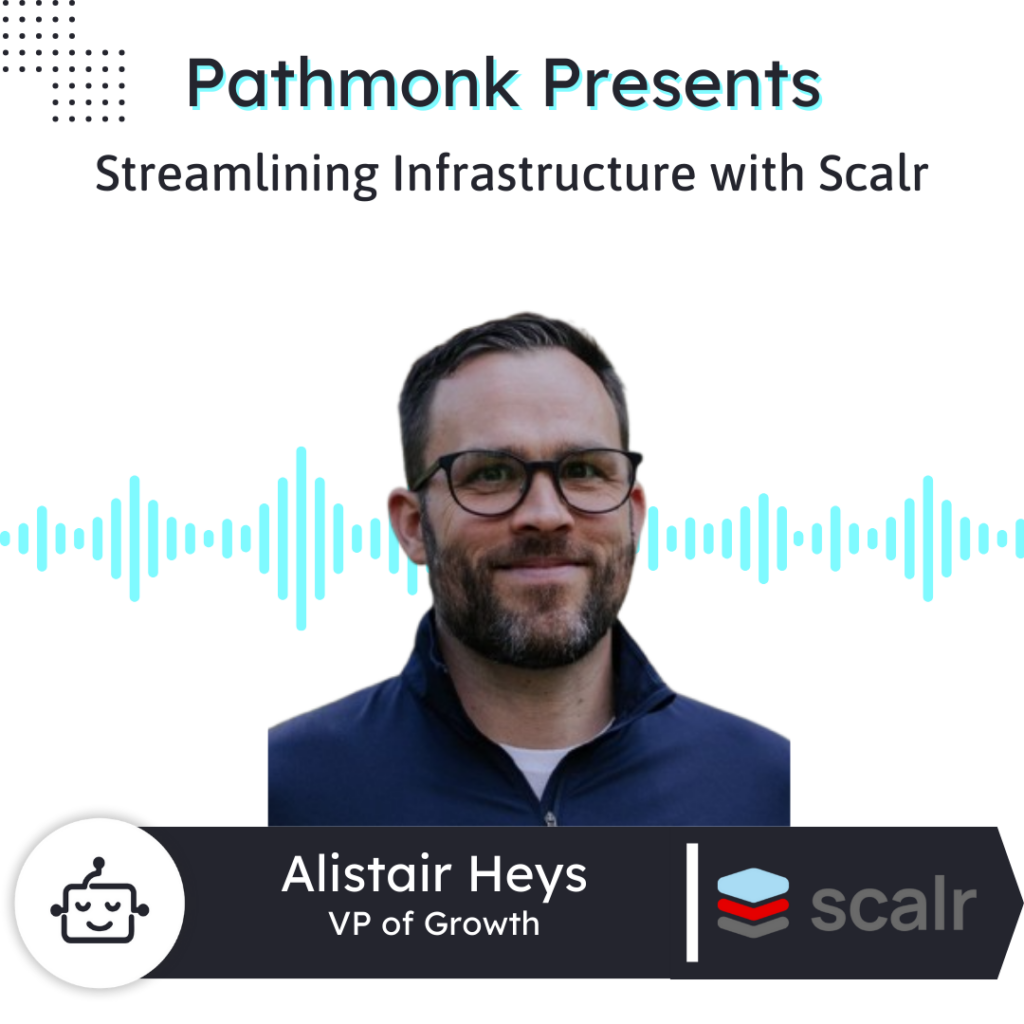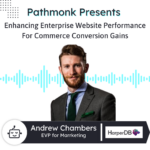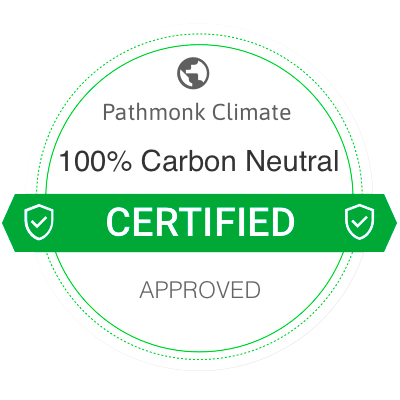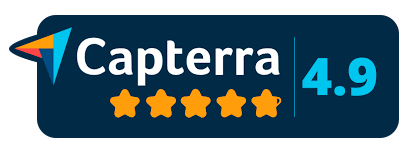
Introduction
On Pathmonk Presents, Alistair Heys, VP of Marketing at Scalr, explains how their platform, built on Open Tofu, empowers developers and DevOps teams to manage infrastructure as code securely and efficiently.
Serving startups to Fortune 10 companies, Scalr simplifies compliance and scaling. Alistair shares their organic growth strategy, focusing on high-value content, LinkedIn, and a robust documentation site to drive sign-ups.
Learn about their usage-based pricing, community-driven approach, and tips for B2B website conversion by understanding user cohorts.
Tune in for insights on aligning marketing with product development for impactful growth!
Increase +180%
leads
demos
sales
bookings
from your website with AI
Get more conversions from your existing website traffic delivering personalized experiences.

Kevin: Welcome back to Pathmonk Presents. Pathmonk is the AI for website conversions. With increasing online competition, over 98% of website visitors don’t convert. The ability to successfully show your value proposition and support visitors in their buying journey is what separates you from the competition.
Pathmonk qualifies and converts leads on your website by identifying where they are in the buying journey and influencing them in key decision moments with relevant micro-experiences like case studies, intro videos, and more. Stay relevant to your visitors and increase conversions by 50% by adding Pathmonk to your website in seconds. Let the artificial intelligence do all the work while you continue your usual marketing efforts. Check us out at Pathmonk.com.
We’re really excited for today’s episode. We’ve got Alistair Heys from Scalr. Alistair, how are you doing today?
Alistair Heys: Good, good. Kevin, how are you?
Kevin: I’m doing quite well. Thanks for joining the show. Before we dive into anything, I’d love to give our audience a chance to understand what Scalr is all about and your role as VP of Marketing there.
Alistair Heys: Sure. I’ll take a step back, because most people probably aren’t familiar with Scalr or infrastructure as code. Infrastructure as code is about managing your services, databases—basically everything you use to build your product—by codifying it instead of manually configuring it, like clicking around in AWS.
We use an open-source tool called OpenTofu that lets developers write configuration files and deploy real infrastructure across any cloud provider—whether public, private, or hybrid. On top of OpenTofu, we build everything that makes scaling easier—collaboration tools, security policy enforcement, and automation. Developers can work faster while staying within guardrails, so changes to production don’t negatively impact the business.
Kevin: So you’re giving developers the tools to move faster and more freely within their environments.
Alistair Heys: Exactly. And in large organizations, it’s often about enabling internal teams to support their developers based on unique needs. Complexity increases rapidly at scale.
Kevin: That’s awesome. Speaking from a marketing and growth perspective, who are your typical customers? Are there certain industries or company sizes that you primarily serve?
Alistair Heys: Our customer base is quite varied. We have everything from early-stage startups using infrastructure as code from day one to Fortune 10 companies with sprawling, complex systems. Startups use it for speed and efficiency with minimal DevOps headcount, while larger companies use it to consolidate systems, standardize processes, and ensure compliance, especially in industries like banking and insurance. Our platform engineering or DevOps users want to automate and build systems that handle compliance and security by default.
Kevin: Sounds like Scalr fits well for companies of any size and helps them scale—true to the name. You mentioned marketing to different personas, sometimes directly to developers and other times to leadership. How do people typically find out about Scalr, and what are your main acquisition channels?
Alistair Heys: Almost all our acquisition is organic. Our focus is getting people into the product. Everyone in the company is focused on building the best product possible. Our users range from software engineers and DevOps to platform engineering managers who want a simpler, more reliable, and cost-effective solution.
Our two main acquisition channels are referrals and organic traffic. We differentiate by removing barriers—there are no gates. We’re usage-based, so people can try us without commitment and gradually migrate from existing or DIY solutions.
Kevin: That makes sense. Can you dive a little deeper into the organic strategy? What’s working for you?
Alistair Heys: Sure. We approach everything with experimentation and measurement. We invest heavily in the product, so marketing leads growth. We believe in value exchange—whatever content or touchpoint we create, it should give the user something of value. We focus on thoughtful blog posts, LinkedIn content, and product marketing that explains why we built something and invites feedback. Our community is high-quality and selective. We don’t chase vanity metrics; we care about getting people into the product.
Kevin: That’s refreshing. Many companies push for quantity—more content, more keywords—but your focus is on quality and community. Shifting gears, what role does your website play in client acquisition?
Alistair Heys: Our website’s main job is to get people to sign up. Most visitors land on internal pages rather than the homepage, and we guide them to pages like pricing, which is a strong differentiator for us. From there, it’s about giving them the info they need and encouraging sign-up.
Our documentation and API docs are particularly strong, which resonates with our technical audience. They can generate calls using non-sensitive company data directly within the docs, showing them the product is built for people like them. We minimize fluff and discourage unnecessary sales interactions—developers can explore and decide for themselves.
Kevin: That approach makes sense. When I visited your site and checked the documentation, I knew right away it wasn’t built for someone like me, and that’s okay. It helps the right users feel at home. Now let’s talk about websites in general. What advice or best practices would you recommend for building a high-converting site?
Alistair Heys: Most B2B websites don’t understand conversion well. There are three types of visitors: new prospects, existing customers, and active users. Each has different needs. You need to segment and understand them to optimize conversion.
For us, the step from website visit to sign-up is performing well, so it’s not our top priority. But without knowing which cohort you’re converting and why, you can end up making changes that improve vanity metrics without real business impact.
Kevin: That aligns with what Pathmonk does—identifying where users are in the buying journey and personalizing their experience. Switching gears, where do you go to keep learning and growing as a marketing professional?
Alistair Heys: I try to vary my sources. I love Lex Fridman’s podcast for deep discussions. I always have a fiction book and a learning-focused book on the go. Reddit is another big one—it’s unfiltered and honest, especially for our audience. I’m also on LinkedIn a lot but try to think critically about trends—what’s the opposite perspective and why might it matter?
Kevin: Interesting. More guests have been bringing up Reddit as a go-to. It makes sense—there’s less fluff and more real feedback. Now, what does your day-to-day look like as a VP of Growth?
Alistair Heys: My work splits into recurring and project-based. Recurring includes planning, forecasting, and analysis. I lead planning cadences and do most of the data work myself to stay close to the numbers. Monday mornings are for reviewing analytics.
Then it’s Slack, emails, and moving between two or three active projects. I use an agile approach—focus on the next deliverable and iterate. I also read every support ticket and feature request. That product mindset keeps me connected to what users need.
Kevin: Sounds like a balanced approach—juggling daily responsibilities with longer-term projects. How do you manage your time between both?
Alistair Heys: It took time to get comfortable. I follow the “Getting Things Done” methodology—capture everything, free up mental space, and use a system. Be upfront about what you can and can’t do, prioritize constantly, and work transparently. I use Jira so anyone can see what I’m working on.
Kevin: Let’s wrap with a quick-fire round. First, what’s the last book you read?
Alistair Heys: The Great Mental Models, Volume One—a framework for building mental tools to solve problems more effectively.
Kevin: If there were no tech boundaries, what’s one thing you’d fix for your role?
Alistair Heys: I’d love to measure users’ true emotional reactions and experiences directly, instead of relying on proxy metrics like clicks. That would help us build genuinely impactful products.
Kevin: What’s one repetitive task you’d automate?
Alistair Heys: Scheduling. I juggle work, personal, and shared calendars. Recently, I started using ChatGPT to analyze calendar screenshots and generate availability—it’s been a game-changer.
Kevin: That’s clever! Finally, what advice would you give yourself if you were starting out in marketing today?
Alistair Heys: Get deep into the product. Build relationships with product managers and engineers. Understand the problems you solve and how the product solves them. That context makes all your marketing far more effective.
Kevin: That’s great advice. Thanks so much, Alistair. Before we sign off, give us a quick reminder—what’s Scalr, and where can people find it?
Alistair Heys: Scalr helps you manage infrastructure as code at scale—safely and efficiently. Visit scalr.com. If you’re a developer or someone working with infrastructure, feel free to try us out or reach out directly.
Kevin: Awesome. Thanks again!











